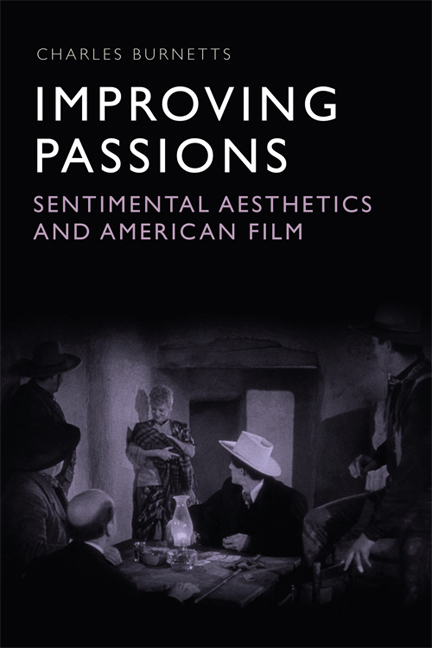Book contents
- Frontmatter
- Contents
- Acknowledgements
- Introduction
- 1 Towards a Genealogy of Sentimentalism in the Eighteenth and Nineteenth Centuries
- 2 Sentimental Aesthetics and Classical Film Theory
- 3 The Sentimental Chaplin: Comedy and Classical Narrative
- 4 Affect, or Postmodern Sentimentalism
- 5 The Sentiments of War in Spielberg and Tarantino
- 6 Sentiment and the ‘Smart’ Melodrama
- Conclusion
- Bibliography
- Index
2 - Sentimental Aesthetics and Classical Film Theory
Published online by Cambridge University Press: 20 December 2017
- Frontmatter
- Contents
- Acknowledgements
- Introduction
- 1 Towards a Genealogy of Sentimentalism in the Eighteenth and Nineteenth Centuries
- 2 Sentimental Aesthetics and Classical Film Theory
- 3 The Sentimental Chaplin: Comedy and Classical Narrative
- 4 Affect, or Postmodern Sentimentalism
- 5 The Sentiments of War in Spielberg and Tarantino
- 6 Sentiment and the ‘Smart’ Melodrama
- Conclusion
- Bibliography
- Index
Summary
Whether understood in terms of the uniquely American unconscious at play in the classical Hollywood vernacular, or the Rousseauian validation of figures untainted by social order, cinema has continuously negotiated the traditions it inherits from the sentimental period, with its own unique set of formal conventions and constraints. A crucial emphasis for what follows below is a thoroughgoing attention to the formal dimensions of the medium within which sentiment has been supposed, at different times, to have been both ubiquitised and utterly dismantled, depending on the governing rubric at hand. Core to these debates rests the place of US culture and Hollywood in the formation of the melodramatic ‘mode’ introduced above, and the complex strands of influence that this may entail. Thus, in his 1943 essay ‘Dickens, Griffith and Film Today’, the Soviet film-maker and theorist Sergei Eisenstein argues:
In order to understand Griffith, one must visualise an America made up of more than visions of speeding automobiles, speeding trains, racing ticker tape, inexorable conveyor belts. One is obliged to comprehend the second side of America – America the traditional, the patriarchal, the provincial. And then you will be considerably less astonished by this link between Griffith and Dickens.
(Eisenstein 1977: 198)Thus, in the latter stages of his life and career, Eisenstein observes a key division in American culture, two ‘faces of America’ that contribute equally and vitally to the national psyche. ‘Super-Dynamic America’ represents the nation's pioneering of new technologies as essential components of a fully rationalised modernity, typified by ‘speeding trains’, Griffith's cinema, and a pervasively kinetic culture. ‘Small Town America’ conversely represents the pastoralism, traditionalism, and sentimentality of a nation that hangs back from such visions of the contemporary, one that is more content with established social structures and ensconced in a hegemony of bourgeois, Victorian, middle-class values. Eisenstein poses Charles Dickens and D. W. Griffith as exponents of both the modernity and sentimentality of their respective cultures, yet applied to their work, the dynamic ‘parallel action’ of cross-cutting scenes (theorised as a precursor to Soviet-montage) is largely valorised over the sympathetic depiction of liberal bourgeois characters, the unredeemed victimhood of a lower class, and a confused scheme of ‘virtue rewarded’. Griffith's ‘classical’ style is deemed by Eisenstein both vital to cinema history yet necessarily inferior ideologically.
- Type
- Chapter
- Information
- Improving PassionsSentimental Aesthetics and American Film, pp. 52 - 77Publisher: Edinburgh University PressPrint publication year: 2017



